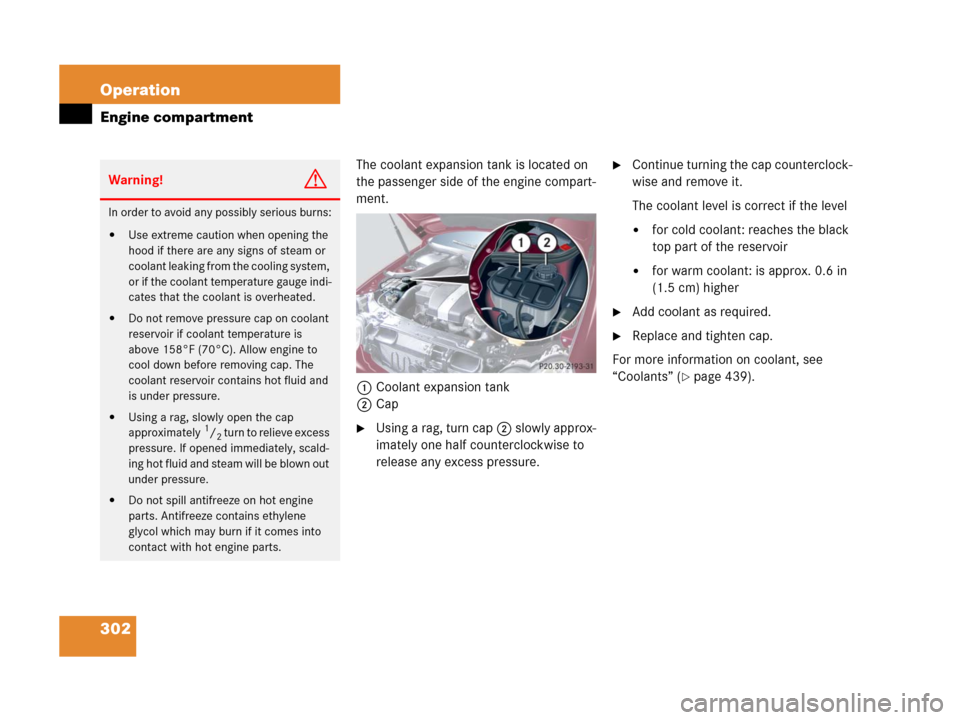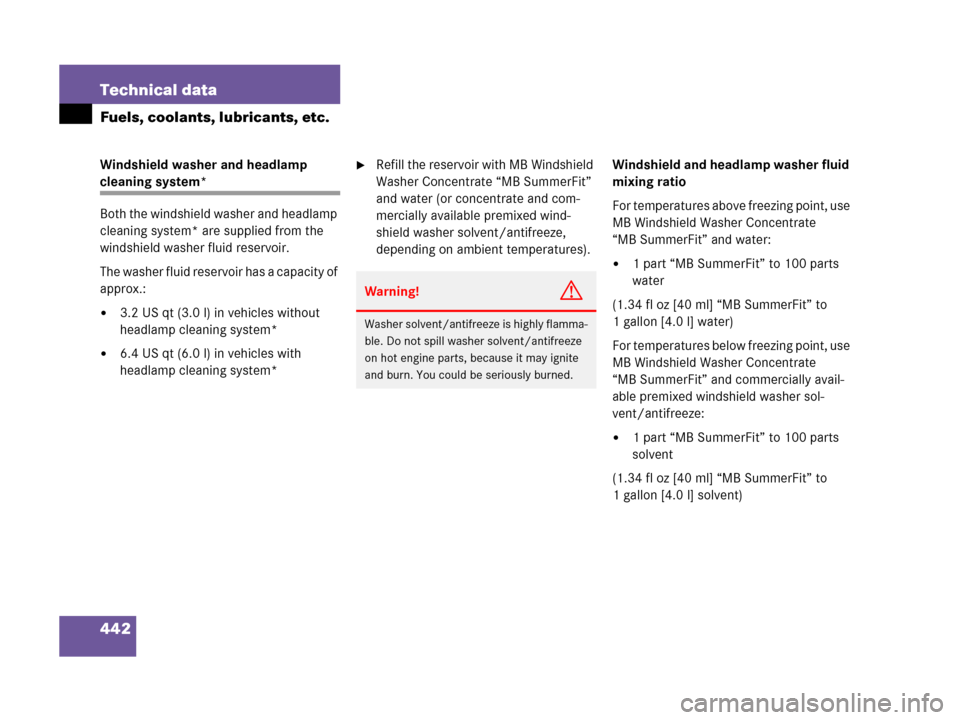Page 296 of 473

295 Operation
At the gas station
Coolant
For normal replenishing, use water (pota-
ble water quality). For more information,
see “Coolant level” (
�page 301) and
“Fuels, coolants, lubricants, etc.”
(
�page 436).
Brake fluid
Removing fuse box cover (
�page 421).Windshield washer and headlamp
cleaning system*
For more information on filling up the
washer reservoir, see “Windshield washer
system and headlamp cleaning system*”
(
�page 304).
Engine oil level
For more information on engine oil level,
see “Engine oil” (
�page 298).Vehicle lighting
Check function and cleanliness. For more
information on replacing light bulbs, see
“Replacing bulbs” (
�page 394).
Exterior lamp switch (
�page 114).
!
If you find that the brake fluid in the
brake fluid reservoir has fallen to the
minimum mark or below, have the
brake system checked for brake pad
thickness and leaks immediately.
Notify an authorized Mercedes-Benz
Center immediately. Do not add brake
fluid as this will not solve the problem.
For more information, see “Practical
hints” (
�page 351).
Page 303 of 473

302 Operation
Engine compartment
The coolant expansion tank is located on
the passenger side of the engine compart-
ment.
1Coolant expansion tank
2Cap
�Using a rag, turn cap2 slowly approx-
imately one half counterclockwise to
release any excess pressure.
�Continue turning the cap counterclock-
wise and remove it.
The coolant level is correct if the level
�for cold coolant: reaches the black
top part of the reservoir
�for warm coolant: is approx. 0.6 in
(1.5 cm) higher
�Add coolant as required.
�Replace and tighten cap.
For more information on coolant, see
“Coolants” (
�page 439).
Warning!G
In order to avoid any possibly serious burns:
�Use extreme caution when opening the
hood if there are any signs of steam or
coolant leaking from the cooling system,
or if the coolant temperature gauge indi-
cates that the coolant is overheated.
�Do not remove pressure cap on coolant
reservoir if coolant temperature is
above 158°F (70°C). Allow engine to
cool down before removing cap. The
coolant reservoir contains hot fluid and
is under pressure.
�Using a rag, slowly open the cap
approximately1/2 turn to relieve excess
pressure. If opened immediately, scald-
ing hot fluid and steam will be blown out
under pressure.
�Do not spill antifreeze on hot engine
parts. Antifreeze contains ethylene
glycol which may burn if it comes into
contact with hot engine parts.
Page 443 of 473

442 Technical data
Fuels, coolants, lubricants, etc.
Windshield washer and headlamp
cleaning system*
Both the windshield washer and headlamp
cleaning system* are supplied from the
windshield washer fluid reservoir.
The washer fluid reservoir has a capacity of
approx.:
�3.2 US qt (3.0 l) in vehicles without
headlamp cleaning system*
�6.4 US qt (6.0 l) in vehicles with
headlamp cleaning system*
�Refill the reservoir with MB Windshield
Washer Concentrate “MB SummerFit”
and water (or concentrate and com-
mercially available premixed wind-
shield washer solvent/antifreeze,
depending on ambient temperatures).Windshield and headlamp washer fluid
mixing ratio
For temperatures above freezing point, use
MB Windshield Washer Concentrate
“MB SummerFit” and water:
�1 part “MB SummerFit” to 100 parts
water
(1.34floz [40ml]“MBSummerFit” to
1 gallon [4.0 l] water)
For temperatures below freezing point, use
MB Windshield Washer Concentrate
“MB SummerFit” and commercially avail-
able premixed windshield washer sol-
vent/antifreeze:
�1 part “MB SummerFit” to 100 parts
solvent
(1.34floz [40ml]“MBSummerFit” to
1 gallon [4.0 l] solvent)
Warning!G
Washer solvent/antifreeze is highly flamma-
ble. Do not spill washer solvent/antifreeze
on hot engine parts, because it may ignite
and burn. You could be seriously burned.